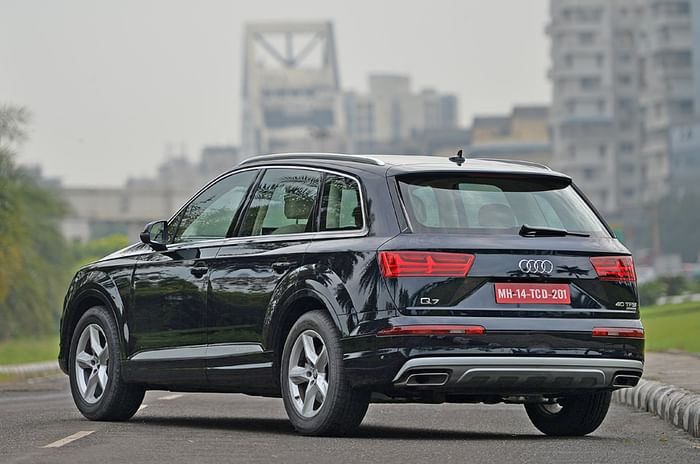2017 Audi Q7 40 TFSI petrol review, test drive
Audi has another go at petrol engine downsizing, but this time with a much bigger target – the massive Q7 SUV.
Published on Sep 15, 2017 12:57:00 PM
35,115 Views
Follow us on



What is it?
Audi shocked the Indian market when it launched its brand-new A4 sedan with a tiny 1.4-litre petrol engine. Sure, in practice, the car performed decently, and even on paper, the outputs of 150hp and 250Nm weren’t terrible. But, in India, it’s all about perception and the downsizing couldn’t be hidden behind the confusing ‘30 TFSI’ badge. Audi has done it again, and this time with a car that’s sure to receive much greater scrutiny – the mighty Q7. That’s because it’s in an altogether more expensive segment where customers are more discerning, and because it’s an SUV, where pulling power matters a lot more.
We’ve had big luxury SUVs with four-cylinder engines before, notably the Mercedes-Benz GLE 250d and the Volvo XC90 D5 and T8, but while those cars’ diesel and petrol-hybrid powertrains afford them upwards of 470Nm of torque, the Q7 40 TFSI (another confusing badge) uses a 2.0-litre, four-cylinder, turbo-petrol engine that produces just 252hp and 370Nm. On the flip side, Audi says it’ll do 0-100kph in 6.9sec; so, perhaps, it won’t be all that bad out in the real world.
What else is new? Not much, really. Rather than attach the space-saver spare tyre where the sixth seat would be, as was originally the case with the diesel, the spare is now entirely optional. This means you get to choose between sacrificing passenger and luggage space or being stranded on the highway after a puncture. And where once a layer of grey cladding ran around the base of the car, it is now just body coloured. This doesn’t look too bad on our dark-coloured car, but we feel it might be more noticeable on a white Q7.
| Audi Q7 Price, Mileage, Specifications, Features and Variants | |
|---|---|
| Brand | Audi |
| Model Name | Q7 |
| Audi Q7 Price | ₹ 1.02 - 1.13 crore |
| Audi Q7 Range/Mileage | Petrol : 11.21kpl |
| Audi Q7 Specifications | SUV | 5 doors | 7 seats View All Specs |
| Audi Q7 Features | LED Matrix headlight | 10.1-inch Touchscreen display | 8 airbags View All Features |
| Audi Q7 Variants | Premium Plus 55 TFSI | Technology 55 TFSI View All Variants |
What’s it like to drive?
On startup and at idle, it’s superbly quiet, so the first job of the petrol variant is taken care of, but then, even as a diesel, the Q7 was always a refined SUV. Unfortunately, you start to feel the effect of the downsizing the moment you set off. There’s a hesitation as you get going from a halt, even when you move off gently. It’s not that the gearbox isn’t ready; it’s just that the engine has a lot of car to move, and while the turbocharger is spooling up, you can feel that it’s working quite hard. The good news is that it’s done spooling up by about 1,800rpm and by 2,000 you get a surge that, although not incredibly strong, feels adequate.
Once you’re cruising at a middling pace, the eight-speed automatic gearbox slurring through its ratios, the Q7 40 TFSI feels just fine, and if you can overlook the slight hiccup you get at the start, you should have no issues. The only other time you might feel a bit of strain, of course, is when you floor the throttle for an overtake. The tacho needle jumps past 3,500rpm, accompanied by a buzz from the engine bay, as the Q7 takes a moment to hike up its skirts and make a run for it. Again, the surge of power here is not immense, but adequate to get the big SUV moving. All in all, it’s certainly nowhere near as smooth or effortless as the V6 diesel in the Q7 45 TDI, but that was only to be expected. Putting the gearbox in ‘S’ does help responses greatly, but it also locks the engine in that buzzy part of its powerband, and for everyday driving, you’re better off keeping it in the regular D mode.
That aside, not much has changed. You still get a supremely comfortable ride from the standard air suspension and respectably tidy body control when it is set to Dynamic mode from the Drive Select menu. As mentioned before, the Q7 is a very refined vehicle, save for a bit of tyre noise from the wide rubber once you pick up the pace on the highway. Credit must also be given to the Auto mode in Drive Select that is quick to detect changes in your driving style and recalibrate the engine, gearbox, suspension and steering to suit; this is the mode we’d leave it in, frankly.
Should I buy one?
The biggest advantage of this 2.0-litre engine is actually the price. Because this displacement gives it a tax advantage, the Q7 40 TFSI starts at an attractive Rs 67.76 lakh (ex-showroom, Delhi), undercutting all its rivals, and even the Rs 74.43 lakh for this top Technology trim is very competitive. To drive, it feels a lot like the A4 30 TFSI did, in that you expect more from it when you first drive it, but after a while, you can get accustomed to the downsizing. We would still recommend the 45 TDI diesel for its immense and effortless performance, and it only costs about Rs 3 lakh more. But for those who have always wanted a petrol Q7, and especially if they’re chauffeur-driven, the 40 TFSI is an adequate alternative. Just don’t go expecting a thrilling performance.
Tech Specs 
Copyright (c) Autocar India. All rights reserved.








 Price
Price Engine
Engine Transmission
Transmission Dimensions
Dimensions
Comments
Member Login
Personal Details
No comments yet. Be the first to comment.